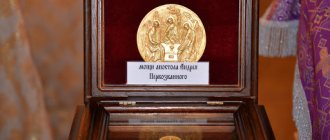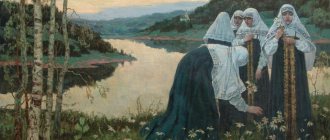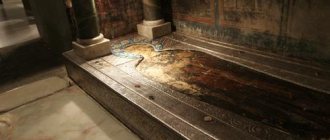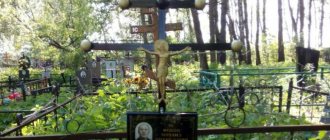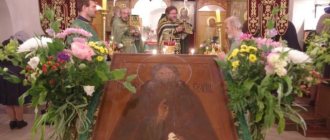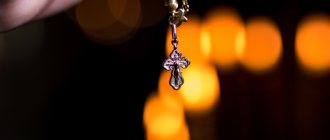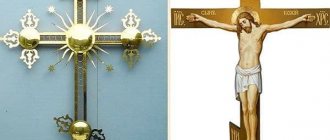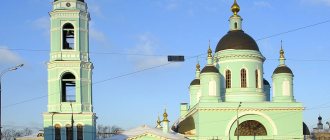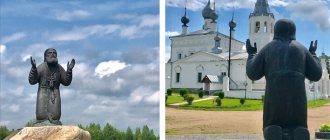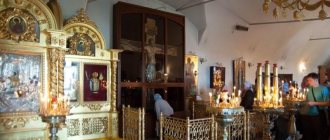Kiysk Cross of Patriarch Nikon in the Church of St. Sergius in Krapivniki The cross was made by order of Patriarch Nikon “from cypress wood, in height and width in all respects similar in measure to the Cross of Christ.” The dimensions of the Cross are 310 by 192 centimeters. The consecration of the Cross took place on August 1, 1656 (on the day of the celebration of the Origin of the Honest Trees of the Life-Giving Cross). In memory of this, on the Cross, in its lower part, a corresponding inscription was made on a gilded tablet.
The Cross contains several hundred particles of the relics of saints and 16 stones - shrines from the sites of biblical events. The cross is decorated with six small wooden crosses depicting the twelve holidays, brought from Athos in the middle of the 17th century. Many of the rare relics of the Cross were taken from the sacristy of the Annunciation Cathedral and the Image Chamber of the Terem Churches of the Moscow Kremlin.
Celebration days:
- Fridays throughout the year, except Friday of Bright Week, are the remembrance of the Passion of the Lord and God and our Savior Jesus Christ on the Cross;
- The 3rd week of Lent, the Worship of the Cross, and the week following it (“a week” in liturgical practice is called Sunday, and a week in the modern sense is called “a week”)
; - August 14 (August 1, old style) - Origin (destruction) of the honorable trees of the Life-giving Cross of the Lord;
- September 27 (September 14, old style) - Exaltation of the Honest and Life-Giving Cross of the Lord.
AT THE FOOT
The Vysoko-Petrovsky Monastery is perhaps the most dear place in Moscow for me. I have been going to Christmas readings for decades now - and here, in the Department of Religious Education and Catechesis, they warmly welcome me, issue accreditation, and then some sections and round tables are held here. In general, I feel at home on Petrovka, and I often came here just for fun, not only at the Readings. You will get off at the Tverskaya metro station, walk along Strastnoy Boulevard, sit on a bench, admiring the domes of such Russian churches as if floating into the air from behind the fortress monastery walls - the Bogolyubskaya Icon of the Mother of God, St. Peter of Moscow, St. Sergius of Radonezh... In one of them certainly service. I knew that a little further - around the corner of the fortress wall - there was another temple of St. Sergius, but for some reason I never went there. Maybe the second name – “in the Wrens” – frightened him off? Or rather, was there such completeness that there was much more holiness? But, as it turned out, it was there that for me, a northerner and a White Sea resident, was the most popular place. Because this small temple houses the largest reliquary in the Eastern and Western Churches, which consecrated the White Sea coast and the entire Russian North for three centuries.
Temple of St. Sergius of Radonezh in Krapivniki
The temple is surrounded on three sides by ancient buildings, the walls of which are decorated with some kind of oriental, Mohammedan ornament. Like Constantinople, besieged by the Turks. I enter under the church vaults. Immediately at the entrance one is greeted by a tall Cross, which at first was mistaken for Golgotha. No, he is the one - Kiysky, from an island in the White Sea.
“Immediately at the entrance you are greeted by a tall Cross - Kiysky, from an island in the White Sea”
As the story goes, in 1639, “in a small boat with a certain Christian,” Hieromonk Nikon, the future Patriarch of Moscow, sailed by sea from the Anzersky monastery and almost drowned from the great excitement of the sea, but, “trusting in the power of the Life-giving Cross,” he was saved and washed up by the waves to the island in front of the Onega mouth. Having stepped onto the granite firmament, he asked: “What is this island? (Whose island is this?)” But since the island was “empty, and unsuitable for habitants, for everything is bare stone,” it didn’t even have a name. Then Nikon said: “Let this island be called Kiy.”
In memory of the rescue, Nikon erected a Cross on the island and after a while asked Tsar Alexei Mikhailovich to grant him a charter that would allow “on that island where Nikon erected the honorable Cross, to build a church and a monastery.” This is how the Cross Monastery appeared on the White Sea. In gratitude for permission to open it, Nikon decided to build and present to the king and the entire royal family a cypress cross, which he “decorated with silver, gold and precious stones, and inside it he placed up to 300 particles of holy relics with the blood of various holy martyrs and with particles of revered Palestinian stones.” Formally, it was a gift to the Tsar, but the great shrine did not remain in Moscow - Nikon soon moved it to the Onega Cross Monastery, on Kiy Island. There, on the White Sea, she remained until 1930.
I venerate myself at the foot of the Cross. I’m trying to make out the Church Slavonic script on a metal tablet compiled by Nikon: “Under the power of the Blessed and Christ-loving Great Sovereign Tsar and Grand Duke Alexy Mikhailovich and all Great and Little and White Russia, the Autocrat and other states of the Sovereign and Possessor... from the honest cypress tree... Christ God! Have mercy and save my soul by the power of the Honest and Life-Giving Cross and the saints for the sake of prayers, whose relics are enshrined in this Cross. From the incarnation of the Word of God 1656, and from the creation of the world 7164 years, August on the first day.” On the Cross there are many metal icons of saints whose relics are enclosed here. I'm being baptized...
Icon “Kiya Cross with Those Awaiting”, painted in 1667 by Bogdan Saltanov. Left: Emperor Constantine, Tsar Alexei Mikhailovich, Patriarch Nikon. Right: Empress Elena, Tsarina Maria Ilyinichna
While waiting for the abbot to arrive, I walk around the entire temple. Worshipers stand in front of two ancient icons - the Theodore Mother of God and St. Sergius of Radonezh, with a particle of his relics. The monk blesses with two fingers - apparently an image of an Old Believer letter. The abbot appears. People line up to get their issues resolved. Then Archpriest Alexander Abramov goes to the chapel, from where the sound of a hammer is heard - work is underway on a new iconostasis. Having freed himself, he invites you to the refectory, for which the parish has been allocated premises in one of the “Mohammedan” buildings.
View details:
Kiy cross in the Church of St. Sergius of Radonezh in Krapivniki
Stone from the “meal where Abraham treated the Holy Trinity”
Inscription at the foot of the Cross
Stone of the Holy Sepulcher. Icons and relics of saints, including the Great Martyr George the Victorious, the Great Martyrs Demetrius of Thessalonica and Panteleimon, the Prophet Daniel, Equal-to-the-Apostles Constantine, the Apostles Matthew and Andrew
Stone from the cave where Christ was born. Relics and icons of saints, including St. Andrew of Crete and Gregory of Nyssa
Temple in Krapivniki
“It’s unusual that your Cross is erected right in front of the entrance,” I ask the first question that comes to mind.
– You saw that the temple was small, and they placed it where the vault is higher. It's a big cross. It was made by order of Nikon in the Holy Land “to the measure of the cross of Christ,” that is, in compliance with the dimensions of the Crucifixion on which the Savior was executed: 3 meters 10 centimeters in height and 1 meter 92 centimeters in width. And in shape it is a copy of the Savior’s tau cross, in the shape of the letter T.
– And this building where we are is somehow Islamic in appearance...
– Here was the courtyard of the Patriarchate of Constantinople, and at one time the temple belonged to it.
– Why is the Kiysky Cross located here now?
– We can say that this is an accident, although providential. But let me tell you better from the very beginning.
Our church of St. Sergius, the Wonderworker of Radonezh, was called by Muscovites differently: “what is in Starye Storozhi”, “what is in Starye Serebryaniki”, “on Petrovka”, “in Krapivniki”, “on Truba”. Basically, it's the same thing. Presumably, the church was built in 1591; the “Petrov Drawing” of 1597 has been preserved, on which you can see a small one-domed temple on the descent from the Vysoko-Petrovsky Monastery to Neglinnaya. That is, the temple already existed under Nikon, and it is quite possible that he prayed here, since he lived nearby. Until the end of the 19th century, it was an ordinary parish church, which eventually became ascribed. When they decided to transfer it to the Serbian courtyard, the people opposed it, because it was the only parish church in Moscow, the main altar of which was consecrated in the name of St. Sergius. The rest were monastic. The requests were heeded and the temple was left assigned to St. Gregory the Theological Church. It was renovated, the iconostasis was gilded, but services were still held only on major holidays. And ten years later, in 1883, by order of Emperor Alexander III, the temple was nevertheless transferred to the courtyard, only of the Patriarchate of Constantinople.
Temple in Krapivniki, old photo
It was then, by 1892, that these buildings, which you called “Islamic,” were erected. Architect Sergei Rodionov decorated the walls with Muslim ornaments, but Russian motifs are also visible in the design. Columns, striped masonry made of colored bricks - it's all Byzantine. As I understand it, the idea was this: Muslims captured Byzantium, but here, in Moscow, Constantinople continues to exist.
House in the “Byzantine-Mohammedan” style
“In 1880, Dostoevsky wrote: “Constantinople must be ours,” I interrupt the story of Fr. Alexandra.
– Yes, at that time, under Emperor Alexander III, there was a question about the liberation of Constantinople and the Orthodox in the Balkans. Perhaps the opening of the farmstead has something to do with this. It was assumed that, as a result of the First World War, the Russians would enter Constantinople, but the revolution turned everything upside down, persecution of the Orthodox began in Russia itself. In the late 20s and early 30s, a wave of mass closures of churches swept across Moscow, but it bypassed Krapivensky Lane. This probably happened because of our eternal sycophancy towards foreigners; the Greeks lived in the courtyard. Perhaps politics was also involved - the Bolsheviks at that time collaborated with Turkey.
It must be said that at the end of the reign of our Patriarch Tikhon, the people of Constantinople were friends here with everyone in the world - both with the renovationists and with the “Tikhonites.” In general, the courtyard had such an unkind, “red-bellied” reputation, and few people came here. Therefore, when the last rector of the metochion, Archimandrite Vasily (Dimopulo), died in 1934, no new priests were appointed here. Those who were junior in rank remained. We established that the last priest, a Crimean Greek by origin, was arrested in January 1938, taken away from here and shot - on charges of espionage for British intelligence. There were no Greek priests left here, and the temple was closed. Moreover, it was closed very thoroughly - everything was taken out of it, nothing was left at all. And the temple was one of the richest in Moscow, judging by the inventory of those valuables that were exported during the confiscation in the 20s.
– And how did the authorities use the temple? Has it been heavily rebuilt?
– They wanted to set up some kind of local history museum, the House of Pioneers. But “at the request of the workers,” they created a skate sharpening station and a workshop that produced these same skates and ski bindings. The fact is that from pre-war times until the early 90s there was a Dynamo skating rink, popular among Muscovites. Have you read Yuri Nagibin’s autobiographical story “Darkness at the End of the Tunnel”? There he writes about his pre-war childhood and the skating rink: “By some miracle, his silver platter fit into the density of the built-up and rebuilt center of Moscow. Here the house encroaches on the house, you won’t find a free spot: between the garbage dump and the garage there is a built-in rabbitry, next to it a shoe shiner has hung out shoelaces and reeks of a sweet shoe polish stench, a cap maker has nestled into some niche, and an electric welder, the owner of a blinding spark, is pressing on him, sheds, substations, all kinds of workshops crowd each other, jostling with elbows, and suddenly the city opens up and, with Dutch generosity, gives its citizens a clear expanse of ice.”
So there was fun and music here for decades - couples rode to the foxtrot “At the samovar, me and my Masha,” and to the songs of Alla Pugacheva. Well, then August 1991 came...
From under the radar
– In August, the Cross was brought here, to the Church of St. Sergius? What a strange coincidence - at the same time there was a putsch by the State Emergency Committee, after which Soviet power ended.
“What’s more surprising to me is that they brought it here.” As I already said, here nearby, on Petrovka, there was a house that belonged to Nikon when he was Metropolitan of Novgorod. And our church is the closest to it among all Moscow churches.
- Maybe someone knew about this?
- Hardly. The following happened. At that time, the Minister of Culture of the RSFSR was Yuri Solomin, well known to us from the film “His Excellency’s Adjutant.” And Yuri Methodievich ordered that part of the icons and shrines in the storerooms be transferred to the churches that suffered the greatest destruction. Well, the Church of St. Sergius was precisely included in this category - the plant was located in it, the bell tower was destroyed, the walls were disfigured. And just the temple was returned to the Church. On August 30, it was consecrated by His Holiness Patriarch Alexy II. The first rector was Archpriest John Ekontsev, later hegumen and archimandrite, known to you from the Christmas readings - he led them for many years. Among the clergy was Archpriest Gleb Kaleda, well-known to many. Later, the clergy moved to the Vysoko-Petrovsky Monastery, when the local church of St. Sergius of Radonezh was returned to the believers. And the restoration of our temple continued - another chapel was consecrated in the name of St. Seraphim of Sarov, the bell tower was restored, and from photographs, the dimensions were observed to the nearest centimeter. But the life of the temple began precisely in August 1991, when three shrines were brought here from the museum storerooms - the icons of the Theodore Mother of God, St. Sergius of Radonezh and the Kiya Cross.
– In whose storerooms was the Cross kept?
– In the storerooms of the Historical Museum on Red Square. He got there from Solovki. In general, before the revolution, the Cross left Kiy Island only during the Crimean War, when it was evacuated to the Solovetsky Monastery, saving it from the British. In the early 20s, after the closure of the Onega Cross Monastery, it was again taken to Solovki, but for a different purpose - to be placed on display in an anti-religious museum. At that time, pamphlets were written about the Kiy Cross, various kinds of ironic messages were called “the department store of non-existent things,” meaning the relics contained in it, and so on.
In the 30s, after the abolition of SLON, the archipelago came under the control of the Navy. A naval base and a school for young boys were located there. The sailors had no need for an anti-religious museum, and the shrines were subject to destruction. Pyotr Dmitrievich Baranovsky, our great restorer, who saved the Kazan Cathedral on Red Square and many other monuments, urgently went to Solovki. He was a man of unprecedented courage, he wrote to the procurator of the USSR navy, demanding that icons, vestments, and utensils be saved. As a result of his efforts, the Kiy Cross was transported to Moscow, to the museum’s storerooms.
The second time the Cross was in danger was in the late 80s and early 90s. We believe that it was prepared to be written off and even taken out of the country. From someone’s point of view, the item was very “valuable”, it was upholstered in silver basma, there was gold leaf, and so on. Fortunately, the curator of another museum, named after Andrei Rublev, was the current priest of the Cathedral of Christ the Savior, Father Georgy Martynov, who knew everything about the Kiy cross and wrote scientific articles about it. And so he organized an entire campaign, updating the theme of the Kiev Cross to such an extent that the Minister of Culture Solomin drew the attention of it. Hence his decision to transfer the shrines from the funds to the temples being restored.
It must be said that museum workers, especially curators, have what can be called “curator’s disease.” It's like a dog in a manger. They proceed from the premise that everyone who comes to their funds intends to steal something. I know a lot of them. As a rule, these are very good people, but they sincerely believe that their task is to show as little as possible and hide as much as possible in the darkness of their funds. And when Father George, who had already become a priest by that time, came to take away the Kiysk cross, as he told me, the fund keeper spat in his face. Emotions were at their limit.
Lost Powers
In the second half of the 19th century. The abbots of the Onega Monastery reported in their reports that part of the relics had been lost. For example. In 1876, Archimandrite Nektariy pointed out the absence of the relics of the Great Martyr Procopius and the Prophet Daniel.
He suggests that, most likely, they were lost when the holy cross was transferred along an inconvenient path from the monastery during the enemy invasion. Then, in 1854, the British came close to the Solovetsky Monastery, and therefore the relic was removed from the monastery.
Beyond loss
“Meanwhile, the deed was done, and now every Muscovite and guest of the capital can venerate the great shrine in our church,” Father Alexander continues the story. – The Kiya Cross is the most significant reliquary existing in both the Eastern and Western Churches. It contains particles of all the relics that were kept in the Patriarchal Palace, in the Terem Chamber - in general, were at the disposal of the Russian Patriarch.
It is noteworthy that the particles of the relics in the Cross are located openly, in small niches. They are filled with wax mastic - a mixture of wax with various incense, similar to that used for the consecration of altars. You've probably seen it in photographs - it is poured into the corners of the throne in the form of a red-hot mass. And so they put the particles into such molten wax mastic, it enveloped them, and then they were simply inserted into the recesses in the Cross, with icons attached next to them, which made it clear whose relics they were. It is known that Nikon ordered icons from the court artist of Tsar Alexei Mikhailovich and the chief master of the Armory, Bogdan Saltanov, whose real name is Astvatsatur, that is, “given by God.” He was an Armenian, originally from Persia. But it is clear that he was not the only one who worked on the icons for the Cross - they were made by different masters and in different iconographic traditions. For example, the martyr Christopher is depicted in an earlier, medieval tradition - with the head of a dog.
Particles of relics in the Cross are located openly, in small niches
– In my opinion, there are less than three hundred icons on the Cross.
– Some of the relics were enclosed without icons. In addition, under the Bolsheviks, the Cross received a loss of gold, which covered the reverse side - and there may also have been particles of relics there.
– Overall, how much has been lost?
– One hundred particles of holy relics remained in the Cross, but about two hundred were missing. What was in the crosshairs was also lost. Shrines characteristic of the seventeenth century were installed there - the milk of the Mother of God, the skin of the Apostle Paul, and so on.
– Usually Catholics had such relics. Under Nikon, European influence was probably significant?
– Undoubtedly, at that time there were some Western trends, but as for the particles of relics, this is what came to the Russian Church from Byzantium, from the Holy Land from the very first times of its existence, that is, long before the seventeenth century.
It should be noted that the Cross suffered losses not only in Soviet times. During the Crimean War he had to be evacuated from Kiy Island to Solovki. After the war, as they wrote in the Arkhangelsk Diocesan Gazette, a commission examined the Solovetsky Monastery and described the damage caused by bombardment from English ships. And when examining the iconostasis of the main temple, into which the Cross was inserted, I found losses in it. Maybe something fell out during the shaking of the shelled building, maybe it happened during transportation - the details were not reported.
– Having lost two-thirds of the particles of relics embedded in it, the Kiy Cross ceased to be the largest reliquary?
– It is still, in theory, our biggest. And then there was simply nothing even close. And the point here is not only in the number of particles of relics. Nowadays we very rarely have such haphazard boxes with relics. Everything that the rector or bishop has is usually collected in separate shrines. Moreover, what happened to be at hand, as if by chance. But here there was a plan, its own iconographic program, which we still cannot understand. Not just relics collected together, but a real reliquary.
– Are you talking about the order of arrangement of particles?
- Yes, about their order. The arrangement of particles does not go in alphabetical order, does not go according to the ranks of certain types of holiness, that is, the venerables, saints, and so on are not grouped separately. But there is undoubtedly some kind of plan there. Many researchers are working to establish it.
Shrines of the Kiev Cross
Eight-pointed stars
• I Stone of the Holy Sepulcher • III Stone from the cave where the Lord fasted for 40 days • VI Stone from the cave where Christ was born • VIII Stone of the Sepulcher of the Blessed Virgin Mary • IX Stone from the cave where John the Baptist prayed • XIV Stone from the cave where John hid Forerunner from Herod • XV Stone from the “meal where Abraham treated the Holy Trinity” • XVI Stone, part of the rod of Moses, “with which he cut off the Red Sea” • II, IV, V, VII, X, XI, XII, XIII Stones not inscribed
Icons and relics of saints
- Great Martyr George the Victorious
- Martyr Christopher
- Martyr Tryphon of Apamea, Nicaea
- Great Martyr Procopius of Caesarea (Palestinian)
- Great Martyr Demetrius of Thessaloniki
- Great Martyr Nikita of Goth, Constantinople
- Great Martyr Mercury of Caesarea (Cappadocia)
- Great Martyr and Healer Panteleimon
- Martyr Anastasius of Aquileia, Salonsky
- Prophet Daniel
- Equal to the Apostles Tsar Constantine
- Apostle and Evangelist Matthew, called Levi
- Apostle Andrew the First-Called
- Prophet, Forerunner and Baptist of the Lord John
- Apostle Paul
- The icon is lost
- Great Martyr Jacob the Persian
- Great Martyr Theodore Stratelates, Heraclean
- Saint Jonah, Metropolitan of Moscow and All Rus'
- Hieromartyr Epherius, Bishop of Chersonesos
- Hieromartyr Cyprian, Bishop of Carthage
- Reverend Alexy, man of God
- Saint Peter of Moscow, Metropolitan of Kiev
- Hieromartyr Theogenes (Fiogenes), Bishop of Paria
- Saint Nektarios, Patriarch of Constantinople
- Hieromartyr Clement, Bishop of Ancyra
- Hieromartyr Peter, Archbishop of Alexandria
- Saint Gregory, Bishop of Nyssa
- Saint Spyridon, Bishop of Trimifuntsky
- Saint Basil the Great, Archbishop of Caesarea in Cappadocia
- Saint John Chrysostom, Archbishop of Constantinople
- Apostle Titus of the 70, Bishop of Crete
- Apostle Stephen from the age of 70, first martyr, archdeacon
- Apostle of the 70 Barnabas (Josiah), Bishop of Milan
- Apostle Thomas Didymus (Gemini)
- Apostle of the 70 and Evangelist Mark
- Righteous Jacob, brother of the Lord according to the flesh
- Apostle of the 70 and Evangelist Luke
- Apostle Timothy of the 70, Bishop of Ephesus
- Righteous Lazarus of the Four Days, friend of God, Bishop of Crete
- Apostle James Zebedee
- Saint Gregory the Theologian, Archbishop of Constantinople
- Hieromartyr Ignatius the God-Bearer, Bishop of Antioch
- Saint John the Merciful, Patriarch of Alexandria
- Hieromartyr Basil, Presbyter of Ancyra
- Saint Epiphanius, Bishop of Cyprus
- Hieromartyr Akepsim, Bishop of Naesson
- Hieromartyr Ermolai, Presbyter of Nicomedia
- Saint Gregory Palamas, Archbishop of Thessalonica (Thessalonian)
- Saint Andrew, Archbishop of Crete
- Hieromartyr Athenogenes, Bishop of Pidakhfoi (Sevastia)
- Saint Philip, Metropolitan of Moscow and All Rus'
- Saint Alexy, Metropolitan of Moscow, Wonderworker of All Rus'
- Saint Gury, Archbishop of Kazan
- Great Martyr Theodore Tiron
- Martyr Eustratius of Sebaste, military leader
- The icon is lost
- Martyr Callinicus of Caesarea (Bifyn)
- Martyr Cyric of Tarsus
- Martyr Callistratus of Byzantium
- Martyr Mamant of Caesarea (Cappadocia)
- Martyr and unmercenary Cosmas of Rome
- Hieromartyr Aviv, Deacon of Edessa
- Hieromartyr Euplus, Archdeacon of Catania (Sicilian)
- Martyr Lucian of Dyrrachium
- Martyr Neophyte of Nicaea
- Martyr and unmercenary Damian of Rome
- Martyr Auxentius of Sebaste, Arabia
- Great Martyr Barbara of Iliopol
- Venerable Anthony the Great, Egyptian
- Venerable Euthymius the Great
- Great Martyr Euphemia of All Praise, Chalcedonian
- Venerable John of Damascus
- Venerable Ephraim the Syrian, Edessa
- Venerable Martyr and Confessor Stephen the New
- Venerable Gregory Dekapolite
- Venerable Pimen the Great
- Venerable Theodore Sikeot, Bishop of Anastasioupol
- Martyr and unmercenary Cyrus of Alexandria
- Rev. George Hozevit
- Rev. Mikhail Malein
- Venerable Nikita, Confessor of Constantinople
- Martyr and unmercenary Cosmas of Arabia, Cilicia
- Venerable Sergius of Radonezh
- Saint Jonah, Archbishop of Novgorod
- Venerable Anthony the Roman, Novgorod
- Righteous Jacob Borovichsky, Novgorod
- Venerable Savva of Storozhevsky, Abbot of Zvenigorod
- Venerable Euthymius of Suzdal
- Blessed Prince Alexander Nevsky
- Blessed Prince Roman Uglichsky
- Great Martyr Marina (Margarita) of Antioch
- Martyr Irene of Aquileia
- Venerable Martyr Anastasia of Rome, Thessalonian (Thessalonian)
- Blessed Prince Vladimir Yaroslavich of Novgorod
- Blessed Prince Georgy (Yuri) Vsevolodovich Vladimirsky
- Holy Blessed Grand Duchess - nun Anna Kashinskaya
- Venerable Martyr Eudokia (Iya) of Rome, Persia
- Venerable Martyr Theodosius the Virgin, Constantinople
- The icon is lost
- The icon is lost
